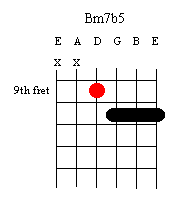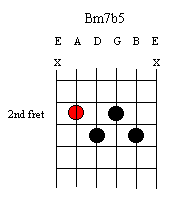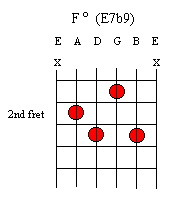
The Diminished scale above is made up of a repeating pattern of Tone+Semitone+Tone+Semitone etc .. which is also called the 2+1 scale eg 2 Semitones + 1 Semitone.
Due to this scales symmetrical nature it is very easy to remember, and offers endless possibilites for guitar patterns which are easy to finger. Diminished patterns have been around for a long time, used in Classical music and especially Jazz, and are now a staple diet for all guitar players.
The obvious use of the Diminished scale is against diminished chords. The small circle next to the chord indicates that it is a diminished chord. These chords are simply made up of minor 3rd intervals one on top of the other. If we take the 1st 3rd 5th and 7th notes from the C Diminished scale we would have the C Diminished Chord.
The diagram below shows another way of writing out the C Diminished scale. Remember that when a minor interval such as a minor 7th ( b7 ) is lowered by a semitone or double flatted it becomes a diminished interval. This is why there is a Bbb in the scale. This way of writing the scale is more in keeping with the Chord Formula for Diminished Chords. eg 1 b3 b5 bb7 Notice also that there are 8 notes in the scale not including the octave.

Taking a closer look at the 4 Diminished chords above, we soon realise that any note in a Diminished chord can be the Tonic. The following table shows how even though there are 12 different Diminished chords, there really are only 3.
| C diminished = | Eb diminished = | F# diminished = | A diminished |
| C# diminished = | E diminished = | G diminished = | Bb diminished |
| D diminished = | F diminished = | Ab diminished = | B diminished |
One of the most IMPORTANT uses of a Diminished 7th chord is to substitute it for a 7b9 chord. Lets look at the notes in a C7b9 chord. The notes are C E G Bb and Db . Compare these notes to the notes in a C# diminished chord. Apart from the tonic note C all the other notes are the same. (The Db being the same as C#) So this means that we can substitute a Diminished 7th chord for any Dominant 7b9 chord so long as we play the diminished chord a semitone above the Tonic of the 7b9 chord.
| B7b9 = | C diminished = | Eb diminished = | F# diminished = | A diminished |
| C7b9 = | C# diminished = | E diminished = | G diminished = | Bb diminished |
| C#7b9 = | D diminished = | F diminished = | Ab diminished = | B diminished |
Now go and drag out all those songs you've been avoiding with 7b9 chords in them and see how easy it is to substitute them with diminished chords. There is always a diminished chord handy because you have 4 diminished chords you can substitute for each 7b9 chord !! Not only that but what scale do you think you can use to improvise over your 7b9 chord ???
One of the most common chord progressions using 7b9 chords is the IIm7b5 to V7b9 progression in a minor key. ( Refer to The Harmonic Minor Chord Scales ) Lets look at a typical progression that moves from Bm7b5 to E7b9 . By substituting F Diminished for the E7b9 chord the chord fingering only requires one note to change from the Bm7b5. The A note just has to be lowered one semitone to Ab to move to the F diminished chord. Try using these easy chord fingerings on those m7b5 to 7b9 progressions and those difficult jazz standards become a breeze to play. Try out your substitutions with these 2 diminished chords, any note in the chord can be the Tonic, which is why all the notes are in red.
 |
 |
 |
 |
Just while we're talking diminished chords, did you know that you can make 4 dominant 7th chords out of each diminished chord. eg Play the diminished chord located on the top 4 strings at the 9th fret. Now move your first finger on the 4th string back one semitone. This is now a Bb7 chord. By lowering any of the notes in a diminished chord one semitone you create a Dominant 7th chord based on the note you have moved to. See examples below.
 |
 |
 |
 |